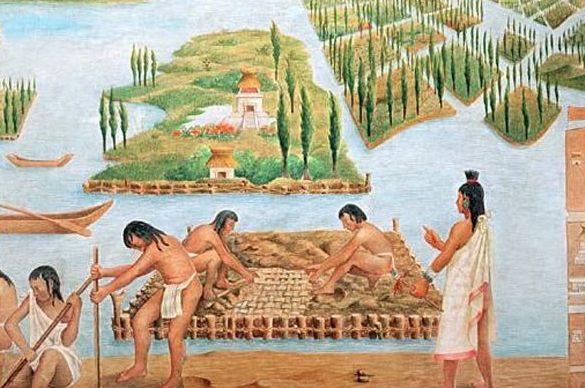1.4 State Building in the Americas from 1200-1450
7 min read•june 18, 2024
W
William Dramby
Riya Patel
AP World History: Modern 🌍
577 resourcesSee Units
Developments in the Americas
Big Picture
When talking about North, Central, and South America in the time period before 1200, the lack of unity and consistency needs to be understood. Because of its limited population and large amount of land, Native Americans were able to live in smaller, regional tribes. Some of these tribes developed into larger civilizations and even empires.
The Mississippian culture is a civilization in modern-day southeastern United States. The Mississippian people created large earthen mounds demonstrating their unity to build large monumental structures. Instead of tracing family lineage through the father’s family, the Mississippian culture was matrilineal, passing social standing through the mother’s blood line.
🎥Watch: WHAP - Connections and Developments in the Americas
Major Empires of the Americas
The Maya and Aztecs each dominated a region of Mesoamerica between 250 CE and 1550 CE. The Maya thrived in the rainforest of the Yucatan peninsula. Largely a kingdom of city-states that worked for mutual benefit, the Maya were able to build large temples, cities, and trade networks.
Because of internal conflict and lack of food, the Maya empire collapsed around 900 CE. Before they collapsed, the Maya thrived, building a famous accurate calendar, a complex writing system, and pyramids that rival those of the Middle East.
The Aztec Empire came years after the collapse of the Maya and occupied modern-day Mexico City and south. Their capital, Tenochtitlan, is where Mexico City is today. The city was enormous, housing nearly 200,000 people at a time when London had 50,000! The Aztecs built a series of great pyramids in their city, demonstrating their power and authority. The amazing part of this city is that it was built on Lake Texcoco. Aztecs would build chinampas, or floating gardens, in the lake to grow a bounty of food. These chinampas would be filled in over time, creating a larger and larger city.

Aztec Chinampas. Image Courtesy of ancient-origins
The Aztecs practiced human sacrifice. Many of the temples in Tenochtitlan were used for these rituals. The people sacrificed were either captured in battle or were tributes given to the Aztecs by neighboring city-states that did not want to be attacked. These prisoners and tributes were often sacrificed to the sun god, Huitzilopochtli. This process of human sacrifice was both part of their polytheistic religion and part of the political rule of the region. The Aztecs were very militaristic, had a thriving merchant class, and promoted education for many of its men.
🎥Watch: WHAP - Continuities in the Americas After 1200 CE
The Incan Empire thrived around the same time as the Aztecs. They dominated a north to south region along the Andes Mountains in South America. They had a lot of clear contrasts with the Aztecs:
- They were much more of a united monarchy, while the Aztecs were largely a city-state empire controlled by Tenochtitlan.
- The Aztecs practiced human sacrifice as part of their religion. They believed that sacrificing humans to their gods would appease them and prevent natural disasters from occurring. The Aztecs also believed that sacrificing humans allowed the gods to renew their own strength, and that the sacrifice of humans would bring about the rebirth of the world. The Aztecs sacrificed prisoners of war, criminals, and slaves, as well as people who were chosen by the gods through a lottery system. The Aztecs believed that the sacrifice of humans was necessary for the continuation of the world and the maintenance of the natural order. The Inca also practiced animal sacrifice, specifically the sacrifice of llamas. Llama sacrifice was an important part of Inca religion and was believed to appease the gods and bring good fortune. Llama sacrifice was performed during important ceremonies and events, such as the coronation of a new ruler or the dedication of a new temple. The llamas were generally adorned with decorative items and were given a special meal before being sacrificed. The blood of the sacrificed llama was collected and offered to the gods, while the meat was often shared among the people as a sacred offering.
- The Aztec civilization, which flourished in Mexico from the 14th to the 16th centuries, had a complex and extensive trade network that stretched throughout much of Mesoamerica. The Aztecs traded a wide variety of goods, including luxury items such as feathers, jade, and gold, as well as practical items such as food, clothing, and tools. The Aztecs used a system of trade routes that connected their capital, Tenochtitlan, to other parts of the empire and to neighboring regions. They also established a number of markets, called tianquiztli, where merchants could buy and sell goods. The Aztecs traded with a variety of partners, including other Mesoamerican civilizations, such as the Maya, and more distant regions, such as Central and South America. The Aztec trade network played a key role in the prosperity and expansion of the empire. The Inca Empire, which flourished in South America in the 15th and 16th centuries, was a state-led society that was characterized by a highly centralized and organized system of government. The Inca state was led by the Sapa Inca, who was the supreme ruler of the empire and was considered to be the descendant of the gods. The Sapa Inca was assisted by a number of officials and administrators, who helped to manage the affairs of the state and ensure that the laws and policies of the empire were enforced. The Inca state was also supported by a complex bureaucracy, which included a system of record-keeping known as the quipu, as well as a system of labor obligations known as the mita. The Inca state was able to exert a strong degree of control over its subjects, and it played a central role in shaping the culture, economy, and society of the empire.
- Mita was a system of labor obligations in the Inca Empire in South America. Under the mita system, all male citizens of the empire were required to perform a certain amount of labor for the state each year. The labor that was required varied depending on the individual's age, occupation, and social status. The mita system was an important part of the Inca economy and was used to construct and maintain public works, such as roads, bridges, and irrigation systems, as well as to support the military and the bureaucracy. The mita system was also used to redistribute wealth and to prevent the concentration of power in the hands of a few wealthy individuals. The mita system was abolished by the Spanish conquistadors in the 16th century, but it has had a lasting impact on the history and culture of the Andean region.
- A quipu, also known as a khipu or talking knot, is a system of record keeping used by the Inca civilization in South America. Quipus were made of strings or cords that were knotted in a complex pattern to represent numbers and other information. Quipus were used for a variety of purposes, including keeping track of tax payments, census data, and records of military campaigns. Quipus were also used for communication, as they could be used to transmit messages over long distances. The quipu system was an important part of the Inca bureaucracy and played a central role in the administration and management of the empire. However, the quipu system was largely destroyed by the Spanish conquistadors, and today much of what we know about quipus comes from the accounts of early Spanish chroniclers.

Image Courtesy of Wikipedia
6. Both the Aztec and Inca were animists and polytheists. Animism is a belief system that holds that all objects, places, and creatures possess a distinct spiritual essence. According to animist belief, everything in the natural world, including animals, plants, and even inanimate objects, has a soul or spirit that is worthy of respect and reverence. Animism is an ancient belief system that has been practiced by indigenous cultures around the world for thousands of years. It is often associated with nature-based religions and shamanistic traditions, and it is based on the idea that the natural world is interconnected and that all living things are connected to one another through a spiritual network. Animism is a broad term that encompasses a wide range of beliefs and practices, and it has been influential in shaping the worldviews and cultures of many indigenous societies. This is why they both have sun gods (Huitzilopochtli and Inti). Polytheism is the belief in multiple gods or deities. It is a type of religion that worships multiple deities, each of which is believed to be responsible for a particular aspect of the natural or spiritual world. Polytheistic belief systems have existed throughout human history and have been practiced by cultures around the world. Some well-known polytheistic religions include ancient Greek and Roman mythology, Hinduism, and many traditional indigenous religions. Polytheistic belief systems often involve the worship of gods and goddesses through rituals and offerings, and they often include a complex mythology that explains the origin and nature of the gods and their relationships to one another and to the world. Polytheism is often contrasted with monotheism, which is the belief in one supreme deity. Both the Aztecs and Inca had hundreds of gods.
Browse Study Guides By Unit
🐎Unit 1 – The Global Tapestry, 1200-1450
🐫Unit 2 – Networks of Exchange, 1200-1450
🕌Unit 3 – Land-Based Empires, 1450-1750
🍕Unit 4 – Transoceanic Interactions, 1450-1750
✊🏽Unit 5 – Revolutions, 1750-1900
🚂Unit 6 – Consequences of Industrialization, 1750-1900
💣Unit 7 – Global Conflict, 1900-Present
🥶Unit 8 – Cold War & Decolonization, 1900-Present
✈️Unit 9 – Globalization, 1900-Present
✏️Frequently Asked Questions
🤔Exam Skills
👉🏼Subject Guides
📝AMSCO Notes

Fiveable
Resources
© 2025 Fiveable Inc. All rights reserved.